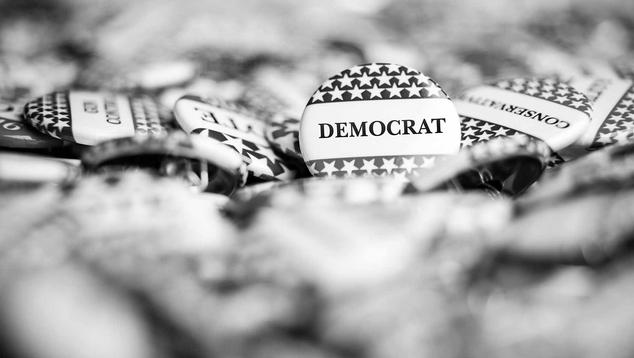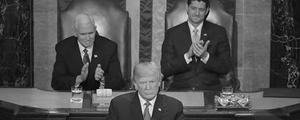Story Highlights
- White Democrats becoming liberal at faster rate than other Democrats
- Rise in education levels a factor in pushing party to the left
- Wide conservative-liberal gaps persist on certain values issues
WASHINGTON, D.C. -- With progressives in the Democratic Party flexing newfound strength in Washington and launching credible campaigns for the 2020 presidential nomination, the party is confronting new questions about who it is and what it stands for. To be effective, the candidates -- as well as Democrats' top-ranking leader, House Speaker Nancy Pelosi -- must discern whether the entire party is shifting, or if the rise of progressives poses a risk to party unity.
Gallup has assembled 18 years of data to look in depth at how the Democrats nationally are changing both demographically and in their political views.
This article addresses the following questions:
-
Is Democrats' trend toward liberalism over the past two decades uniform within the party or has it occurred more among some groups than among others?
-
How has the demographic profile of Americans identifying as Democrats changed, and what implications does that have for the ideological makeup of the party?
-
Who constitutes the subgroups of liberal, moderate and conservative Democrats today?
-
How, if at all, have liberal, moderate and conservative Democrats' views on specific issues changed?
Background
As Gallup has previously reported, the percentage of Democrats nationally who identify as politically liberal has been increasing. This has occurred in three distinct phases: 1) 2001-2006, when the percentage was trending steadily upward; 2) 2007-2012, when liberalism held steady near 40% for several years in a row and 3) 2013-2018, when liberalism resumed its upward trajectory.
The percentage of Democrats identifying as politically liberal averaged 32% in the first period, 39% in the second and 46% in the third. At the same time, the percentages identifying as conservative and moderate fell equally.
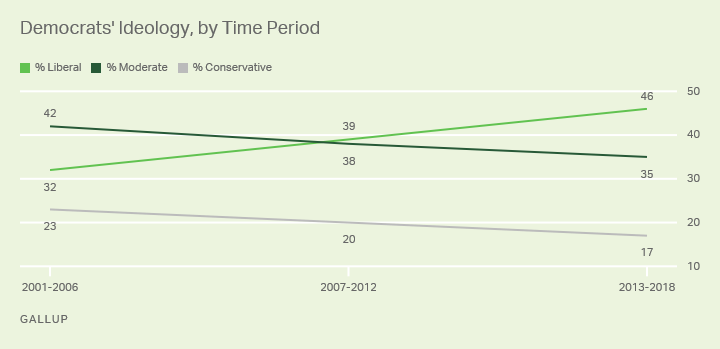
These figures are based on combined data from Gallup surveys conducted from 2001 through 2018, encompassing more than 30,000 interviews with self-identified Democrats in each six-year period.
Whites and College Grads Jump the Most in Liberal Self-Identification
The increase in Democrats' self-identification as liberal is seen among various subgroups within the party. However, this has occurred to differing degrees among men, women, young adults, seniors, people of varying education levels and the different major racial/ethnic groups.
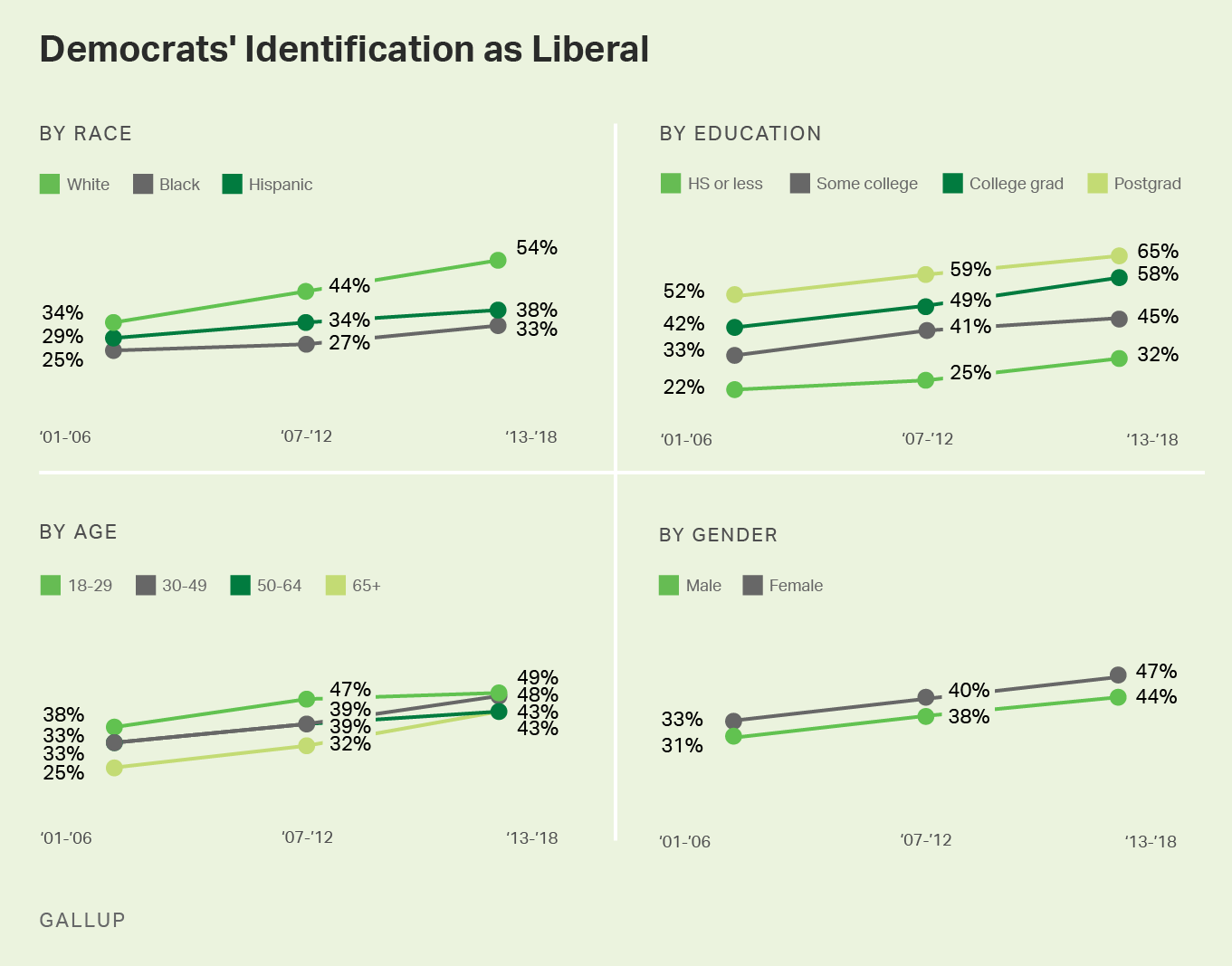
Increased liberal identification has been particularly pronounced among non-Hispanic white Democrats, rising 20 percentage points from an average 34% in the early 2000s to 54% in the latest period. By contrast, Gallup trends show a nine-point rise in the percent liberal among Hispanic Democrats, from 29% to 38%, and an eight-point increase among black Democrats, from 25% to 33%.
Democrats' ideology has long varied by education level, with more-highly educated Democrats significantly more likely to identify as liberal than those with lower education levels. That pattern has persisted since 2001-2006, though one education group -- those with a college degree only -- has shifted more than the others. The percentage liberal has gone up 16 points among Democrats with a college degree only, 13 points among postgraduates, 12 points among those who have attended some college and 10 points among those with no college education.
Younger Democrats have generally been more likely than older Democrats to identify as politically liberal; however, the generational gap has narrowed in recent years because of a sharper increase among older Democrats. Liberal identification is up 18 points among those 65 and older between the 2001-2006 and 2013-2018 periods, versus an 11-point increase among those aged 18 to 29.
Nearly identical percentages of Democratic men and women have identified as politically liberal over the years, although women have been consistently two to three points higher than men.
Makeup of Democratic Party Changing: More College-Educated, Less White
Modest changes have also occurred in the demographic makeup of Democrats as a whole since the 2001-2006 period. And some of these changes help explain the increase in liberalism.
-
The percentage of Democrats with college degrees has increased from 27% in 2001-2006 to 35% in 2013-2018.
-
Conforming with broader societal trends, the percentage of nonwhite Democrats has swelled from 31% in 2001-2006 to 43% in 2013-2018.
-
Also consistent with societal changes -- although more pronounced among Democrats than nationally -- the percentage with no religion has doubled, from 10% to 20%, while the share identifying with a Christian religion has fallen 12 points to 70%.
Meanwhile, the composition of Democrats on the basis of gender and age has been fairly steady.
| 2001-2006 | 2007-2012 | 2013-2018 | ||||||||||||||||||||||||||||||||||||||||||||||||||||||||||||||||||||||||||||||||||||||||||||||||||
|---|---|---|---|---|---|---|---|---|---|---|---|---|---|---|---|---|---|---|---|---|---|---|---|---|---|---|---|---|---|---|---|---|---|---|---|---|---|---|---|---|---|---|---|---|---|---|---|---|---|---|---|---|---|---|---|---|---|---|---|---|---|---|---|---|---|---|---|---|---|---|---|---|---|---|---|---|---|---|---|---|---|---|---|---|---|---|---|---|---|---|---|---|---|---|---|---|---|---|---|---|
| % | % | % | ||||||||||||||||||||||||||||||||||||||||||||||||||||||||||||||||||||||||||||||||||||||||||||||||||
| RACE | ||||||||||||||||||||||||||||||||||||||||||||||||||||||||||||||||||||||||||||||||||||||||||||||||||||
| Non-Hispanic white | 68 | 65 | 56 | |||||||||||||||||||||||||||||||||||||||||||||||||||||||||||||||||||||||||||||||||||||||||||||||||
| Nonwhite | 31 | 33 | 43 | |||||||||||||||||||||||||||||||||||||||||||||||||||||||||||||||||||||||||||||||||||||||||||||||||
| EDUCATION | ||||||||||||||||||||||||||||||||||||||||||||||||||||||||||||||||||||||||||||||||||||||||||||||||||||
| Postgraduate | 15 | 18 | 18 | |||||||||||||||||||||||||||||||||||||||||||||||||||||||||||||||||||||||||||||||||||||||||||||||||
| College graduate only | 12 | 13 | 17 | |||||||||||||||||||||||||||||||||||||||||||||||||||||||||||||||||||||||||||||||||||||||||||||||||
| Some college | 30 | 30 | 27 | |||||||||||||||||||||||||||||||||||||||||||||||||||||||||||||||||||||||||||||||||||||||||||||||||
| No college | 43 | 39 | 38 | |||||||||||||||||||||||||||||||||||||||||||||||||||||||||||||||||||||||||||||||||||||||||||||||||
| Total college graduate | 27 | 31 | 35 | |||||||||||||||||||||||||||||||||||||||||||||||||||||||||||||||||||||||||||||||||||||||||||||||||
| Total college nongraduate | 73 | 69 | 65 | |||||||||||||||||||||||||||||||||||||||||||||||||||||||||||||||||||||||||||||||||||||||||||||||||
| RELIGION | ||||||||||||||||||||||||||||||||||||||||||||||||||||||||||||||||||||||||||||||||||||||||||||||||||||
| Christian | 82 | 76 | 70 | |||||||||||||||||||||||||||||||||||||||||||||||||||||||||||||||||||||||||||||||||||||||||||||||||
| Other religion | 7 | 7 | 8 | |||||||||||||||||||||||||||||||||||||||||||||||||||||||||||||||||||||||||||||||||||||||||||||||||
| No religion | 10 | 15 | 20 | |||||||||||||||||||||||||||||||||||||||||||||||||||||||||||||||||||||||||||||||||||||||||||||||||
| GENDER | ||||||||||||||||||||||||||||||||||||||||||||||||||||||||||||||||||||||||||||||||||||||||||||||||||||
| Men | 40 | 40 | 39 | |||||||||||||||||||||||||||||||||||||||||||||||||||||||||||||||||||||||||||||||||||||||||||||||||
| Women | 60 | 60 | 61 | |||||||||||||||||||||||||||||||||||||||||||||||||||||||||||||||||||||||||||||||||||||||||||||||||
| AGE | ||||||||||||||||||||||||||||||||||||||||||||||||||||||||||||||||||||||||||||||||||||||||||||||||||||
| 18-29 | 17 | 18 | 21 | |||||||||||||||||||||||||||||||||||||||||||||||||||||||||||||||||||||||||||||||||||||||||||||||||
| 30-49 | 38 | 34 | 32 | |||||||||||||||||||||||||||||||||||||||||||||||||||||||||||||||||||||||||||||||||||||||||||||||||
| 50-64 | 24 | 27 | 27 | |||||||||||||||||||||||||||||||||||||||||||||||||||||||||||||||||||||||||||||||||||||||||||||||||
| 65+ | 21 | 21 | 21 | |||||||||||||||||||||||||||||||||||||||||||||||||||||||||||||||||||||||||||||||||||||||||||||||||
| GALLUP | ||||||||||||||||||||||||||||||||||||||||||||||||||||||||||||||||||||||||||||||||||||||||||||||||||||
Because black and Hispanic Democrats are less likely than white Democrats to self-identify as liberal, it might be expected that the expanding nonwhite share of the Democratic population would have resulted in a smaller increase in the percentage of Democrats overall who identify as liberal. However, nonwhites' influence on Democrats' ideology is more than offset by the expanding proportion of college-educated Democrats -- the latter being among the most liberal of all Democratic subgroups.
Relatedly, educational attainment has expanded the most among white Democrats, with the percentage of all college graduates (including postgrads) increasing by 13 points, from 29% in 2001-2006 to 42% in 2013-2018.
Gallup has found little to no increase in educational attainment among Hispanic and black Democrats.
| 2001-2006 | 2007-2012 | 2013-2018 | Increase | ||||||||||||||||||||||||||||||||||||||||||||||||||||||||||||||||||||||||||||||||||||||||||||||||
|---|---|---|---|---|---|---|---|---|---|---|---|---|---|---|---|---|---|---|---|---|---|---|---|---|---|---|---|---|---|---|---|---|---|---|---|---|---|---|---|---|---|---|---|---|---|---|---|---|---|---|---|---|---|---|---|---|---|---|---|---|---|---|---|---|---|---|---|---|---|---|---|---|---|---|---|---|---|---|---|---|---|---|---|---|---|---|---|---|---|---|---|---|---|---|---|---|---|---|---|
| % | % | % | (pct. pts.) | ||||||||||||||||||||||||||||||||||||||||||||||||||||||||||||||||||||||||||||||||||||||||||||||||
| White | 29 | 35 | 42 | 13 | |||||||||||||||||||||||||||||||||||||||||||||||||||||||||||||||||||||||||||||||||||||||||||||||
| Black | 21 | 23 | 24 | 3 | |||||||||||||||||||||||||||||||||||||||||||||||||||||||||||||||||||||||||||||||||||||||||||||||
| Hispanic | 19 | 21 | 20 | 1 | |||||||||||||||||||||||||||||||||||||||||||||||||||||||||||||||||||||||||||||||||||||||||||||||
| Note: College-educated includes postgraduates | |||||||||||||||||||||||||||||||||||||||||||||||||||||||||||||||||||||||||||||||||||||||||||||||||||
| GALLUP | |||||||||||||||||||||||||||||||||||||||||||||||||||||||||||||||||||||||||||||||||||||||||||||||||||
Who Are Liberal, Moderate and Conservative Democrats?
Education represents the biggest differentiator between liberal, moderate and conservative Democrats today. Nearly half of liberal Democrats (47%) in the 2013-2018 period are college graduates, versus 31% of moderate Democrats and 13% of conservative Democrats.
Race is the next-biggest factor, as two-thirds of liberal Democrats are white, compared with 52% of moderate Democrats and 40% of conservative Democrats. In fact, nearly as many conservative Democrats are black as are white, even though there are far more whites than blacks in the U.S. population and in the Democratic base overall.
Liberal Democrats are also a bit younger on average than either moderate or conservative Democrats.
| Liberal | Moderate | Conservative | ||||||||||||||||||||||||||||||||||||||||||||||||||||||||||||||||||||||||||||||||||||||||||||||||||
|---|---|---|---|---|---|---|---|---|---|---|---|---|---|---|---|---|---|---|---|---|---|---|---|---|---|---|---|---|---|---|---|---|---|---|---|---|---|---|---|---|---|---|---|---|---|---|---|---|---|---|---|---|---|---|---|---|---|---|---|---|---|---|---|---|---|---|---|---|---|---|---|---|---|---|---|---|---|---|---|---|---|---|---|---|---|---|---|---|---|---|---|---|---|---|---|---|---|---|---|---|
| % | % | % | ||||||||||||||||||||||||||||||||||||||||||||||||||||||||||||||||||||||||||||||||||||||||||||||||||
| EDUCATION | ||||||||||||||||||||||||||||||||||||||||||||||||||||||||||||||||||||||||||||||||||||||||||||||||||||
| Postgraduate | 26 | 15 | 5 | |||||||||||||||||||||||||||||||||||||||||||||||||||||||||||||||||||||||||||||||||||||||||||||||||
| College graduate | 21 | 16 | 8 | |||||||||||||||||||||||||||||||||||||||||||||||||||||||||||||||||||||||||||||||||||||||||||||||||
| Some college | 27 | 29 | 26 | |||||||||||||||||||||||||||||||||||||||||||||||||||||||||||||||||||||||||||||||||||||||||||||||||
| High school or less | 26 | 40 | 60 | |||||||||||||||||||||||||||||||||||||||||||||||||||||||||||||||||||||||||||||||||||||||||||||||||
| Total college graduate | 47 | 31 | 13 | |||||||||||||||||||||||||||||||||||||||||||||||||||||||||||||||||||||||||||||||||||||||||||||||||
| Total college nongraduate | 53 | 69 | 86 | |||||||||||||||||||||||||||||||||||||||||||||||||||||||||||||||||||||||||||||||||||||||||||||||||
| RACE | ||||||||||||||||||||||||||||||||||||||||||||||||||||||||||||||||||||||||||||||||||||||||||||||||||||
| Non-Hispanic white | 65 | 52 | 40 | |||||||||||||||||||||||||||||||||||||||||||||||||||||||||||||||||||||||||||||||||||||||||||||||||
| Non-Hispanic black | 17 | 28 | 35 | |||||||||||||||||||||||||||||||||||||||||||||||||||||||||||||||||||||||||||||||||||||||||||||||||
| Hispanic | 13 | 16 | 22 | |||||||||||||||||||||||||||||||||||||||||||||||||||||||||||||||||||||||||||||||||||||||||||||||||
| AGE | ||||||||||||||||||||||||||||||||||||||||||||||||||||||||||||||||||||||||||||||||||||||||||||||||||||
| 18-29 | 22 | 20 | 17 | |||||||||||||||||||||||||||||||||||||||||||||||||||||||||||||||||||||||||||||||||||||||||||||||||
| 30-49 | 34 | 32 | 29 | |||||||||||||||||||||||||||||||||||||||||||||||||||||||||||||||||||||||||||||||||||||||||||||||||
| 50-64 | 25 | 27 | 30 | |||||||||||||||||||||||||||||||||||||||||||||||||||||||||||||||||||||||||||||||||||||||||||||||||
| 65+ | 20 | 21 | 23 | |||||||||||||||||||||||||||||||||||||||||||||||||||||||||||||||||||||||||||||||||||||||||||||||||
| Total under 50 | 56 | 52 | 46 | |||||||||||||||||||||||||||||||||||||||||||||||||||||||||||||||||||||||||||||||||||||||||||||||||
| GENDER | ||||||||||||||||||||||||||||||||||||||||||||||||||||||||||||||||||||||||||||||||||||||||||||||||||||
| Men | 38 | 40 | 44 | |||||||||||||||||||||||||||||||||||||||||||||||||||||||||||||||||||||||||||||||||||||||||||||||||
| Women | 62 | 60 | 56 | |||||||||||||||||||||||||||||||||||||||||||||||||||||||||||||||||||||||||||||||||||||||||||||||||
| GALLUP | ||||||||||||||||||||||||||||||||||||||||||||||||||||||||||||||||||||||||||||||||||||||||||||||||||||
Democratic Unity on Taxes, Global Warming, Gun Control
Recent Gallup analysis confirms that Democrats' increasing identification as liberal is more than a matter of ideological self-labeling -- Democrats are indeed expressing more liberal viewpoints on a wide swath of issues. The key insight for party leaders to know is whether these shifts are happening uniformly within the party, or more with some groups than others.
The following table summarizes the views of liberal, moderate and conservative Democrats on issues where there is broad agreement across the three groups. Although their levels of support for each position vary, the three groups are on the same side when it comes to beliefs that corporations and upper-income Americans pay too little in taxes and that global warming is caused by human activities. Also, all three groups support stricter gun laws, broadly approve of labor unions and want to see union influence expanded.
Additionally, despite recent discussion about the extent of Democrats' support for Israel, fewer than a third of Democrats in any of the ideological groups say they sympathize more with the Palestinians than the Israelis in the Middle East conflict.
On almost all of these issues, the views of each Democratic ideological subgroup have either become more liberal or been stable over time.
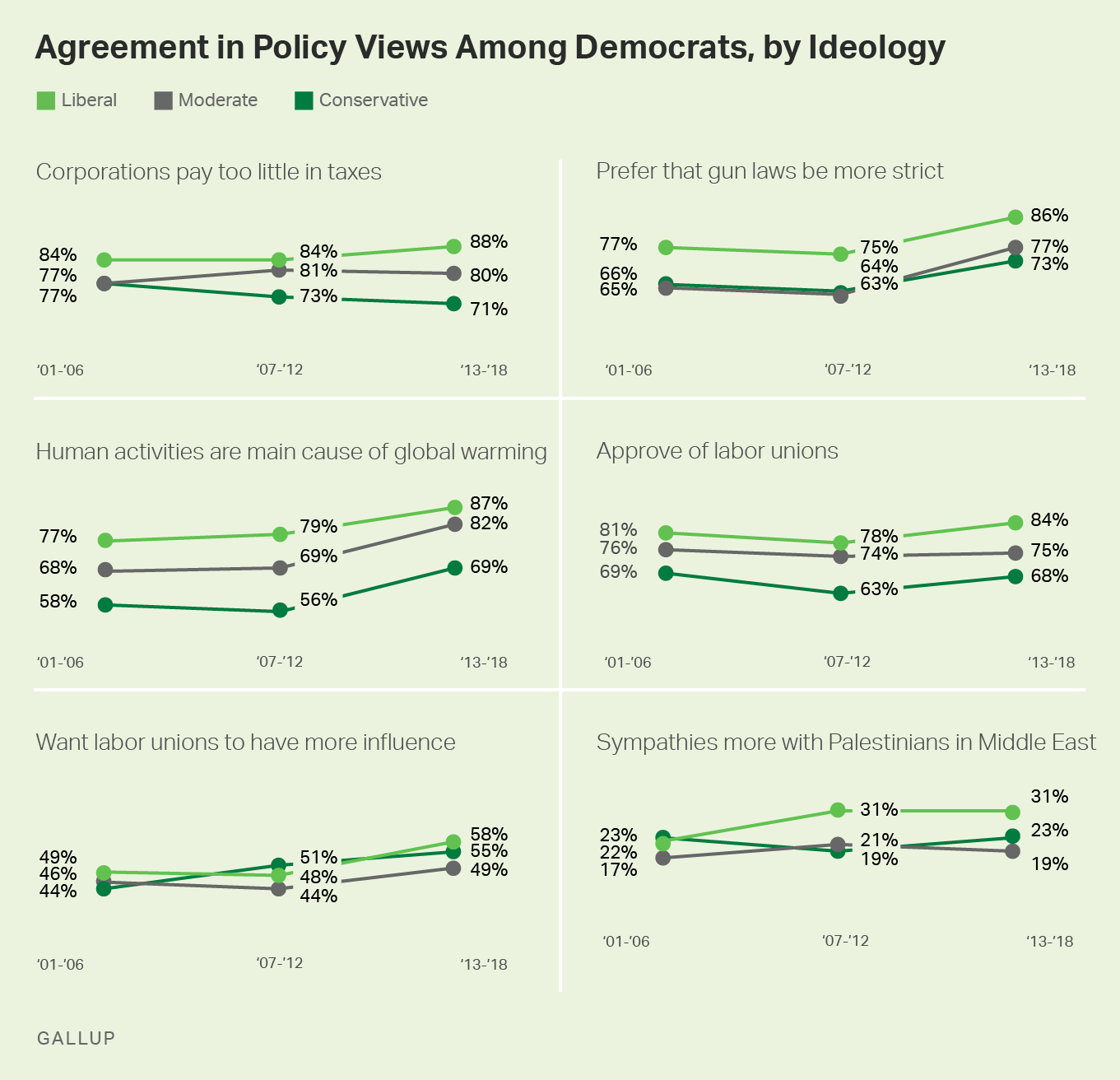
Fundamental Disagreement Seen on Abortion, Healthcare, Marijuana
Conservative and liberal Democrats diverge sharply on other issues, particularly on certain values-related matters, with moderate Democrats generally falling somewhere in between.
The key areas of intra-Democratic friction involve abortion, embryonic stem cell research, the death penalty, doctor-assisted suicide, defense spending, government-run healthcare, same-sex marriage, legalization of marijuana and whether global warming is a looming threat. Solid majorities of liberal Democrats, versus less than half of conservative Democrats, hold the traditionally liberal positions on these issues.
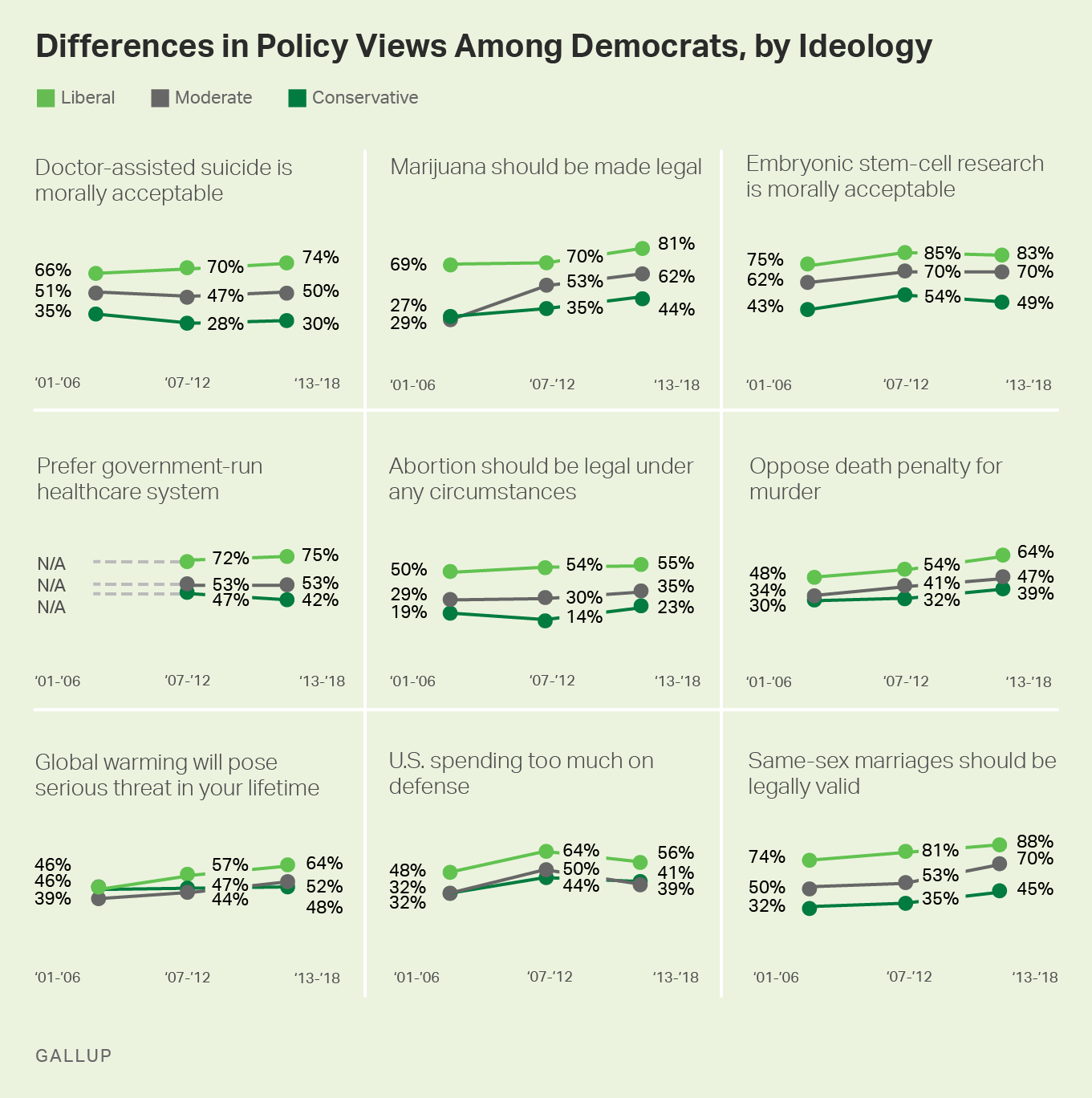
Moderate Democrats come closer to conservative Democrats on abortion, the death penalty, defense spending, healthcare and the threat of global warming. They are closer to liberal Democrats on embryonic stem-cell research and same-sex marriage. They fall squarely in between the two on doctor-assisted suicide and legalizing marijuana.
Democrats' views have grown slightly more liberal on several of these issues within each of the ideological strands, such as the death penalty, same-sex marriage and the threat of global warming. However, differences across the three groups have persisted over time.
Bottom Line
As Democrats assume more power in Washington and start the process of choosing their standard-bearer for 2020, several factors reviewed here could be important to future Democratic unity.
-
Democrats, as a whole, are becoming more liberal, and this is seen across all subgroups.
-
Increased liberalism has been more pronounced among white than among black or Hispanic Democrats, and white Democrats are now majority liberal.
-
An increase in college education among Democrats, particularly white Democrats, may be a major contributor to the party's liberal shift.
-
Majorities of liberal, moderate and conservative Democrats share similar outlooks on corporate and upper-income tax rates, gun control, the human role in global warming and labor unions.
-
Democrats diverge by ideology on a variety of issues, such as doctor-assisted suicide, abortion, defense spending and government-run healthcare.
Taken together, these findings suggest that proposals to shrink the wealth gap, strengthen labor unions and address climate change could have broad appeal in the party. At the same time, Democrats risk alienating center-right elements of the party should they move far to the left on certain social issues, government-run healthcare or defense spending.
The Democrats' grand unifier, however, stands outside the party. Despite differing ideologies and opposing views on some issues, on average last year, 82% of conservative Democrats, 91% of moderate Democrats and 96% of liberal Democrats disapproved of the job President Donald Trump was doing as president. That suggests few Democrats would back Trump in 2020, even if their party lurches far to the left. The bigger risk would be dampening voter enthusiasm and turnout among centrist and right-leaning Democrats. That can be avoided by treading carefully on issues where strong intraparty divisions persist.
Learn more about how the Gallup Poll Social Series works.
